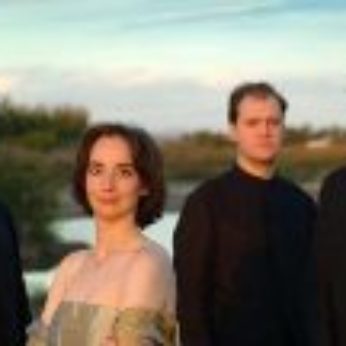Composer: Franz Schubert (b. 1797 - d. 1828)
Performance date: 28/06/2013
Venue: Bantry Library
Composition Year: 1824
Duration: 00:35:40
Recording Engineer: Damian Chennells, RTÉ lyric fm
Instrumentation: pf
Instrumentation Category:String Quartet
Artists:
Cuarteto Casals (Abel Tomás Realp, Vera Martinez Mehner [violins], Jonathan Brown [viola], Arnau Tomás Realp [cello]) -
[quartet]

Schubert’s
Rosamunde Quartet was written at a
time when he knew his health was damaged beyond repair. Earlier in the spring
of 1824 he had poured out his heart to one of his friends, quoting Gretchen am Spinnrade, one of his most
famous songs – Meine Ruh ist hin, mein
Herz ist schwer, ich finde sie nimmer und nimmermehr. Imagine a man, his
letter went, whose most brilliant hopes
have perished, to whom the felicity of love and friendship have nothing to offer
but pain at best… His illness often forced him into isolation and it even
affected his ability to sing and to play the piano. But it did not, to our
lasting benefit, stop him from composing.
The
Rosamunde begins like a song with a
gently rocking accompaniment figure in the lower strings over which the first
violin sings the song. This hypnotic accompaniment figure is very close to the
famous spinning wheel accompaniment to Gretchen;
as in his D minor Quartet which followed soon after, Schubert is recalling
the songs he wrote in his youth and seeing them in a very different light.
The
second subject, also a notable theme but dwarfed by Schubert’s obsession with
his song melody, is distinguished by the trill on its second note, which
persists even when the theme changes its shape. The short development
concentrates exclusively on the magical opening theme culminating in a tough
exercise in counterpoint. This leads to an appalled throbbing in the cello
while the theme floats consolingly above. The coda returns a last time to his
song as if he cannot bear to leave it.
The
tranquil theme of the Andante is
familiar from the Rosamunde
incidental music, which had been put together in a great hurry the previous
December. Although this Quartet was not finished until March 1824, it seems
more likely that Schubert plundered his half-written Quartet for the incidental
music than the other way around. The form of this movement is as simple as the
tune, ABABcoda, where the coda combines both themes. The Rosamunde theme takes so long to present and the second theme flows
so naturally out of the first, that this movement also takes on the appearance
of being as monothematic as the preceding one. Just once the drama of the
composer’s life bursts through the tranquillity but without succeeding in
disturbing the overall mood.
“Schöne Welt, wo
bist du?” is
the question asked by the song from which Schubert took the theme for his
minuet. The cello keeps on putting the question to the other instruments, whose
swaying rhythm provides an inconclusive answer. The Trio is a gentle major-key
interlude. The only answer to Schiller’s and Schubert’s question lies of course
in the beauty of the poetry and the music.
The
A major Rondo stays with the questioning and uncertain mood despite the
apparently jovial nature of the main theme. There are many hesitations and
stallings as well as a minor key second subject and the coda avoids any easy
affirmation.
Copyright © 2025 West Cork Music. All rights reserved.
Designed and developed by Matrix Internet